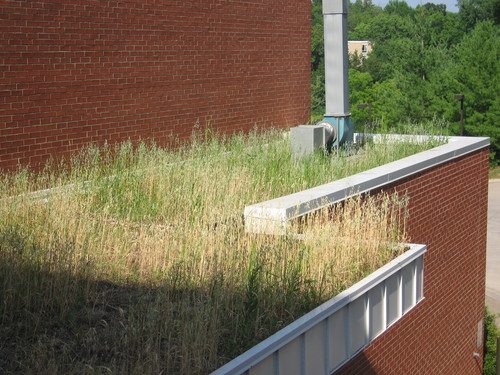
Although the Carleton College Green Roof is still in its infancy at two and half years old, it’s legacy is already starting to fade. Few people on Carleton’s campus notice the small, 666 sq ft. patch of prairie located on a roof outside the Olin- Mudd indoor “link”. The informational sign overlooking the green roof is now sun-bleached and tattered. Even fewer people at Carleton, with the exception of only a handful of current seniors, remember the week of May 13th-19th, 2005 when Dave Holman (’06), Jason Lord (’06), Jake Gold (’07), Mandi Fix (’08), and Andrew Kaplan (‘08) spent countless hours on top of the Olin chemical storage facility installing the roof.
Why the decline in excitement and activity surrounding the green roof on campus? It’s important to acknowledge that students aren’t entirely responsible for this seeming lack of focus. After all, the annual flux of new freshman and graduated seniors doesn’t make it easy to keep long-term projects like the green roof alive. So how can students rise to the challenge of overcoming the generational disconnect created every four years and simultaneously ensure that Carleton students don’t reinvent the wheel? The simple answer is this: through reeducation. Students at Carleton need to be informed about projects others might consider to be long finished in order to inspire and equip the next generation of Carleton students to build from those initiatives.
Before delving into the specifics of Carleton’s green roof, it is important to begin with the basics. A green roof (rooftop garden, eco-roof, vegetated roofs, or living roof as it is sometimes called) is a roof of a building that is partially or completely covered with vegetation and a growing medium layered on top of a waterproof membrane. Green roofs are beneficial additions to buildings for many reasons. Installing a green roof reduces stormwater runoff, filters air and water pollutants (CO2 and acid rain are examples), decreases urban heat island effect, expands habitat space for insects and birds, and extends a roof’s lifespan by limiting the temperature effect on roof expansion and contraction.
According to the Minnesota Green Roofs Council, green roofs are most prevalent in Germany where approximately one in twenty buildings has a green roof. In North America, the City of Chicago is at the forefront of green roof installation with two million sq feet of green roof in existence or in the process of being installed as of 2006. Green roofs are also on the rise in Minnesota. The number of green roofs in Minnesota has doubled in the past five years.
At Carleton, the inspiration for a green roof came from a few students who had taken “Eco-house Design”, a course taught by Richard Strong, a green architect and former Director of Facilities. They chose the Olin chemical storage building because it is one of the strongest buildings and is in a highly visible location on campus. The students planted 78 varieties of native Minnesota prairie plants (54 species of prairie forbs, 3 types of shrub/vine species, 19 species of grasses, sedges, and rushes, and a cover crop of oats). The growth medium consisted of a mixture of compost, vermiculite, perlite, and clay particles.
Since the planting, Carleton students have utilized the roof for several research projects. Students have conducted experiments comparing the water quality and volume of stormwater runoff from the green roof to a nearby roof. A biology professor and a team of students also began a plant survey to determine biodiversity on the roof. In addition to being a place of scientific research, the roof has been featured in art projects and has provided a quiet spot to study on beautiful days when it just doesn’t feel right to be in the library. More recently, students have shifted their focus to plans for a larger and professionally-done green roof. There has been talk of designing a green roof which doubles as a sculpture garden to be built on the Collaboratory, the new arts building. Another idea is to install a green roof on an Eco-house, a building that Carleton would build or retrofit to serve as a model for energy efficient technologies and sustainable design.
These are only a few possible ideas. College campuses across the nation have put together creative proposals for green roof installations. They have conducted valuable studies, given tours for local residents interested in building their own green roofs, grown vegetables, created roof art…the list goes on. So you might ask, what next? That’s for this generation to decide.
A green roof tour open to all who are interested in visiting the roof will be scheduled soon. To read more about the Carleton College Green Roof, visit the Green Roof webpage, attend a SOPE meeting Wednesday night at 9, or e-mail oxtobyl@carleton.edu.
Sources
Minnesota Green Roofs Council